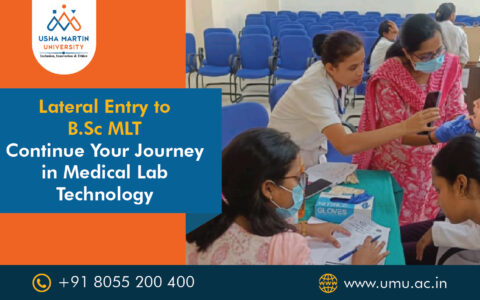
Lateral Entry to BSc MLT – Continue Your Journey in Medical Lab Technology
April 19, 2025What is BMRIT?
Those interested in the healthcare industry who are searching beyond traditional jobs like nursing or medicine may be wise to pursue a B.Sc. in Medical Radiology and Imaging Technology (BMRIT). Below is a summary of the reasons you could select this course and what your future may hold:
Students who are enthusiastic about healthcare technology and patient service can consider pursuing a B.Sc. at MRIT. Usha Martin University is top paramedical college in Jharkhand that provides options for global employment, career progression, and steady job prospects. This is a possibility to think about if you want to work in healthcare in a high-tech, high-impact role without becoming a doctor.
Why Pick MRIT for Your B.Sc.?
Radiology course is in high demand in healthcare since it is essential to diagnosis and care. Every hospital and diagnostic facility needs qualified personnel for everything from X-rays to MRIs and CT scans.
- The Edge of Technology: MRIT offers a dynamic work environment and ongoing development through improving imaging techniques by fusing cutting-edge technology with healthcare.
- Diverse Educational Opportunities: Anatomy, physiology, radiation physics, imaging methods, patient care, and equipment handling are all covered in the course.
- Quicker Access to Employment: B.Sc. Compared to lengthy medical degrees, MRIT is usually a 3–4 year curriculum, allowing you to begin your career relatively early.
- Crucial Function in Patient Care: Working closely with patients, radiologic technologists play a critical role in the diagnostic process and frequently aid in the early detection of life-threatening illnesses.
Role of Medical Radiology and Imaging Technology (MRIT)
Modern healthcare relies heavily on Medical Radiology and Imaging Technology (MRIT). It involves diagnosing, tracking, and treating medical diseases with the use of sophisticated imaging equipment. MRIT specialists are adept in running imaging equipment and guaranteeing safe, high-quality diagnostic pictures.
MRIT professionals’ primary duties and responsibilities include:
- Using imaging equipment: Utilize mammography, ultrasound, CT (Computerized Tomography), MRI (Magnetic Resonance Imaging), and X-ray equipment.
- Modify settings to take precise, unclouded pictures for diagnosis.
Preparation & Patient Care
- Get patients ready for operations: Reduce worry, guarantee comfort, and explain imaging procedures.
- Safety and Radiation Protection: Adhere to stringent guidelines to reduce radiation exposure.
Wear Safety gear for themselves and your patients.
Analysis and Processing of Images: Take, examine, and save medical pictures.
Make sure the image quality is sufficient for radiologists or doctors to interpret it accurately.5. Supporting Diagnosis
- Give radiologists the appropriate imaging data so they can interpret it.
- Are essential in identifying disorders, internal bleeding, malignancies, and fractures.
Maintenance of Equipment
- Check and calibrate imaging equipment on a regular basis.
- Report malfunctions or technical problems as soon as possible.
Maintaining Records and Reporting
- Keep track of imaging reports and patient records.
- Make use of RIS (Radiology Information System) and PACS (Picture Archiving and Communication System).
Specialized Functions in Intervention Techniques
- Help with image-guided biopsies or procedures.
- Encourage the use of least invasive techniques for diagnosis and treatment.
Where BMRIT Professionals Work –
- Hospitals (Radiology Department)
- Diagnostic Labs & Imaging Centers
- Emergency Rooms & Trauma Units
- Cancer Treatment Centers
- Orthopedic & Neurology Clinics
- Mobile Imaging Units
- Tele-radiology Services
- Research & Academic Institutions
MRIT professionals pursue paramedical course which are the backbone of diagnostic healthcare. They combine medical knowledge, patient care, and technical expertise to produce images that are vital for accurate diagnosis and treatment. Their work ensures timely medical decisions, enhances patient outcomes, and supports the efficiency of healthcare systems.
Career Scope After (BMRIT) Radiology Course –
After completing your degree, you can work in:
- Hospitals (Govt. & Private)
- Diagnostic Labs & Imaging Centers
- Cancer Treatment Centers
- Trauma Centers
- Mobile Imaging Units
- Research Institutes
- Educational Institutions (as trainers or lecturers)
The job opportunities are vast after pursuing a BSc Medical Radiology and Imaging Technology (B.Sc. MRIT) due to the growing importance of diagnostic imaging in modern healthcare.
Top Job Opportunities After B.Sc. MRIT
- Radiologic Technologist / Radiographer
- Operate X-ray, CT, MRI, and other imaging equipment.
- Work in hospitals, diagnostic centers, or mobile units.
- MRI & CT Scan Technologist
- Specialized role focused on advanced imaging.
- High demand in urban hospitals and diagnostic labs.
- X-ray Technician
- One of the most common roles for MRIT graduates.
- Needed in almost every hospital and clinic.
- Ultrasound Technician / Sonographer (with additional certification)
- Specialize in ultrasound scanning for various medical purposes.
- Cath Lab Technician (Cardiac imaging specialty)
- Involved in imaging for heart-related diagnostics and interventions.
- Diagnostic Medical Sonographer
- Specialize in imaging soft tissues and internal organs.
- Radiology Information System (RIS) Operator
- Manage radiology data and reports using hospital systems.
- Application Specialist (Medical Imaging Equipment Companies)
- Work with companies like GE, Siemens, or Philips to train healthcare professionals on using imaging equipment.
- Research Assistant in Medical Imaging Projects
- Join clinical research teams in hospitals or academic institutions.
- Teaching / Academic Roles (after higher studies)
- Become a lecturer or trainer in paramedical or radiology institutes.
Sectors Hiring BMRIT Graduates –
- Government & Private Hospitals
- Diagnostic & Imaging Centers
- Cancer & Trauma Centers
- Orthopedic Clinics
- Medical Equipment Companies
- Tele-radiology Firms
- International Healthcare Providers (UAE, UK, Canada, Australia)
Job Market Outlook –
Due to the increasing dependence on imaging technologies for diagnosis, radiology technologists are now indispensable in medical settings. With advancements like AI in imaging and digital health records, the scope is expanding fast—making MRIT one of the most promising allied healthcare careers.
Future Opportunities & Growth after Radiology BMRIT Course –
- Higher Studies
- M.Sc. in Radiology/Imaging Technology
- MBA in Hospital Administration
- PG Diploma in Advanced Imaging Techniques
- Abroad Opportunities Countries like the UAE, Canada, Australia, and the UK offer excellent packages for radiology technologists with certifications and experience.
- Research and Development Contribute to innovations in imaging techniques or work with medical equipment manufacturers.
- Teaching and Academia With experience and higher education, you can become a lecturer or trainer in colleges.
B.Sc. Radiology course admission in MRIT is a future-ready program that combines healthcare and technology, offering an exciting and meaningful career path. With the increasing reliance on diagnostic imaging in modern medicine, skilled radiology professionals are in high demand across the globe. The course opens doors to diverse job opportunities, attractive salaries, and potential for specialization or international placements. Whether you aim to work in hospitals, research, or continue with higher studies, BSc Medical Radiology & imaging Technology (BMRIT) provides a solid foundation for a rewarding and impactful healthcare career.





